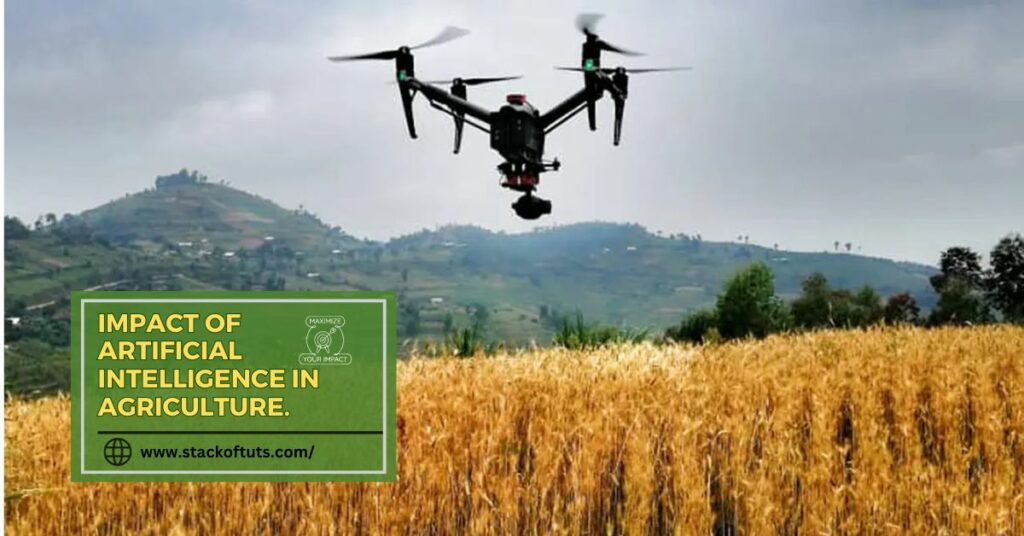
The agricultural sector has been the backbone of numerous economies worldwide. Over time, farming methods have evolved, from early tools to machinery, and now to the era of digital transformation. One significant transformation that promises to revolutionize agriculture is the impact of artificial intelligence on agriculture. This advancement has brought in unprecedented changes, making agriculture smarter and more efficient than ever.
The impact of artificial intelligence on agriculture is not just limited to increased crop yields but encompasses various facets of farming, right from sowing to harvesting and beyond.
For a complete guide also read about Artificial intelligence used in Agriculture dive into this link for exclusive insights and captivating discoveries!”
What is AI?
Before delving into the impacts, it’s essential to understand what artificial intelligence (AI) is. AI refers to the simulation of human intelligence in machines, especially computer systems. These machines are designed to mimic human actions, reason through logical deduction, and learn from mistakes. In essence, AI is the brainpower that enables machines to think, decide, and act like humans.
Impact of artificial intelligence on agriculture: A Comprehensive Guide
Agriculture has always been a cornerstone of human civilization, undergoing various transformations through the ages. The introduction of artificial intelligence (AI) to this sector is one of the most significant advancements in recent history. Let’s delve deep into how AI impacts agriculture, ensuring we break it down in simple terms.
1). Increased crop yields

How does AI achieve this?
By collecting data from various sensors and satellite images, AI can analyze the health of crops in real time. It provides insights into the optimal times for sowing, the right amount of irrigation, and more. Predictive algorithms can also anticipate potential pests or diseases, allowing for early interventions.
Why is it important?
Higher yields mean more produce. This not only benefits the farmer’s income but also ensures food security for the growing global population.
2). Reduced Costs

How does AI achieve this?
Through precision farming, AI ensures that resources like water, fertilizers, and pesticides are used only where and when they are needed. Automated machines can perform tasks efficiently, reducing the need for manual labor.
Why is it important?
Lower costs mean higher profit margins for farmers. It also makes food production more economical, which can lead to more affordable prices for consumers.
3). Mitigated Environmental Impacts

How does AI achieve this?
AI-driven systems optimize resource usage, ensuring minimal waste. For example, smart irrigation systems use water efficiently, reducing waste. Furthermore, AI can predict the best crop rotation strategies, maintaining soil health and reducing the need for chemical fertilizers.
Why is it important?
Sustainable agricultural practices ensure that our environment isn’t degraded, preserving it for future generations. Healthy ecosystems lead to a balanced environment and a decrease in adverse climate effects.
4). Improved food safety

How does AI achieve this?
AI can monitor crops and livestock for diseases in real time. By catching and addressing these issues early, the chances of contaminated food entering the supply chain are reduced.
Why is it important?
Food safety is paramount. Consumption of tainted food can lead to health issues, including food poisoning and even long-term diseases.
5). More Sustainable Farming Practices

How does AI achieve this?
AI promotes practices like precision farming, which minimizes resource waste. It can also guide farmers on sustainable practices, like which crops to grow in succession to maintain soil fertility.
Why is it important?
Sustainable farming ensures that the land remains fertile and productive over the long term. It reduces the strain on natural resources and promotes biodiversity.
6). New and Innovative Food and Agriculture Technologies

How does AI achieve this?
AI fosters innovation. From creating drought-resistant crop varieties through data analysis to developing new farming equipment that can work round-the-clock, the possibilities are endless.
Why is it important?
Innovation ensures that agriculture keeps pace with the changing world. As challenges like climate change and growing populations arise, new technologies can offer solutions to ensure food security and sustainability.
Sources of artificial intelligence
- Drones (UAVs): flying robots equipped with cameras; used for crop monitoring and pest detection.
- Satellites: orbiting devices with sensors; ideal for large-scale farmland monitoring and weather prediction.
- Soil Sensors: Devices buried in soil to measure parameters like moisture and pH; aid in irrigation and fertility assessment.
- Weather Stations: Facilities gathering atmospheric data; assisting in crop prediction; and providing disaster alerts.
Challenges of Using AI in Agriculture

Agriculture’s amalgamation with artificial intelligence (AI) offers immense potential. However, its implementation is not devoid of challenges. Here are some of the challenges faced while integrating AI into agriculture:
- High Initial Costs: Deploying AI technologies, from drones to sophisticated sensors, requires a substantial financial investment. Many small-scale farmers might find the costs prohibitive.
- Technical Infrastructure: Adequate technical infrastructure, like internet connectivity, is essential for many AI applications. In many rural areas, this infrastructure might be lacking or inconsistent.
- Dependency on Technology: Excessive reliance on technology can become problematic, especially if there are malfunctions or errors in the AI systems, leading to potential crop losses.
- Skill Gap: Not all farmers are equipped with the knowledge or skills to operate AI-driven tools. There’s a steep learning curve associated with these technologies.
- Data Privacy Concerns: AI in agriculture relies heavily on data. Issues related to data ownership, access, and misuse can be significant concerns.
- Environmental Factors: The unpredictable nature of weather and environmental conditions can sometimes render AI predictions inaccurate.
- Ethical and Social Implications: The automation of tasks can lead to job losses in the sector. This raises concerns about the economic and social consequences for agricultural communities.
Opportunities for AI to Further Transform the Food and Agriculture Sector

Despite the challenges, AI continues to unfold a range of opportunities that can revolutionize agriculture.
- Soil Health Analysis: AI can predict the health of the soil, providing insights into its nutritional composition. This can inform farmers about which crops to plant and when.
- Smart Livestock Farming: From monitoring the health of animals to optimizing feeding times using sensors, AI can make livestock farming more efficient and humane.
- Post-Harvest Monitoring: AI can be used to monitor the storage conditions of harvested crops, ensuring they remain fresh and are stored under optimal conditions.
- Supply Chain Optimization: AI can predict demand, optimize pricing, and streamline the distribution process, ensuring that farm produce reaches the consumer swiftly and efficiently.
- Climate Impact Modeling: With the increasing concerns about climate change, AI can be used to model how different climatic conditions might impact crop yields, helping farmers prepare better.
- Agricultural Robotics: Machines equipped with AI can perform a multitude of tasks, from planting seeds to harvesting crops. This not only increases efficiency but also reduces the human labor required.
- Enhancing Genetic Research: AI can be used to analyze the genetic makeup of crops, potentially leading to the development of more resilient and nutritious crop varieties.
FAQs
AI, or artificial intelligence, in agriculture, refers to the use of machines and software that can perform tasks that typically require human intelligence. This includes analyzing soil health, predicting crop yields, automating irrigation systems, and more.
AI offers several benefits, such as increased crop yields, reduced costs, improved food safety, and more sustainable farming practices. It also provides insights that can help farmers make more informed decisions.
Yes, while AI holds great potential, challenges include high initial costs, dependency on technology, potential data privacy concerns, and a skill gap among farmers in using advanced tech tools.
Absolutely! AI can model climate impacts, helping farmers adapt to changing conditions. It can also assist in developing more resilient crop varieties and optimizing resource use, reducing environmental strain.
Conclusion
In conclusion, the impact of artificial intelligence on agriculture is profound and transformative. It offers the potential to address food security issues and enhance productivity. However, as with all technological advances, it’s essential to navigate the challenges with foresight and sensitivity.
Thanks!





